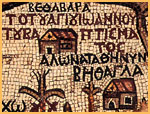|
Peoples and languages in Early Byzantium
In the Early Byzantine empire, Greek (in the east)
and Latin (in the west)  were
the two languages of administration and culture. Greek was
traditionally spoken in Greece and Cyprus, along the coastal
strips of Asia Minor, and on the southern shore of the Crimea;
further east, it was widespread in those cities established
during Hellenistic rule, such as Antioch, Apamea, Seleucia
and Laodicea. Similarly, Latin was the dominant language in
Italy and the extensively romanized north African coast. But
the Early Byzantine empire was also a mosaic of countries
and ethnicities, where most of the ordinary country folk spoke
neither Greek or Latin. Inland Asia Minor, for example, was
populated with indigenous peoples and long time immigrants,
such as the Celts of Galatia or the Jews of Phrygia, all of
which spoke their native languages (Phrygian, Celtic, Cappadocian,
Isaurian). To the east of Asia Minor, lived a series of Caucasian
people, among which Armenians and Iberians (Georgians) had
strong feelings of national identity and languages of their
own. To the south of Armenia, the frontier district of Mesopotamia,
as well as the lands of Syria and Palestine, spoke mainly
Aramaic languages, such as Syriac and Hebrew. Sedentary and
nomadic Arabs living in Syria and Palestine long before the
Arab conquest of the seventh century, also spoke their native
language. Beyond the Palestinian desert lay the land of Egypt,
where apart from a few Greek strongholds, such as Alexandria,
Naukratis and Ptolemais, Egyptian (Coptic) was the dominant
language. In North Africa, local dialects (Berber and remnants
of ancient Phoenician) coexisted with the administrative Latin.
The native peoples of the Balkans, Illyrians to the west,
Thracians and Daco-Mysians to the East, spoke Illyrian and
Thracian (in particular Bessic). were
the two languages of administration and culture. Greek was
traditionally spoken in Greece and Cyprus, along the coastal
strips of Asia Minor, and on the southern shore of the Crimea;
further east, it was widespread in those cities established
during Hellenistic rule, such as Antioch, Apamea, Seleucia
and Laodicea. Similarly, Latin was the dominant language in
Italy and the extensively romanized north African coast. But
the Early Byzantine empire was also a mosaic of countries
and ethnicities, where most of the ordinary country folk spoke
neither Greek or Latin. Inland Asia Minor, for example, was
populated with indigenous peoples and long time immigrants,
such as the Celts of Galatia or the Jews of Phrygia, all of
which spoke their native languages (Phrygian, Celtic, Cappadocian,
Isaurian). To the east of Asia Minor, lived a series of Caucasian
people, among which Armenians and Iberians (Georgians) had
strong feelings of national identity and languages of their
own. To the south of Armenia, the frontier district of Mesopotamia,
as well as the lands of Syria and Palestine, spoke mainly
Aramaic languages, such as Syriac and Hebrew. Sedentary and
nomadic Arabs living in Syria and Palestine long before the
Arab conquest of the seventh century, also spoke their native
language. Beyond the Palestinian desert lay the land of Egypt,
where apart from a few Greek strongholds, such as Alexandria,
Naukratis and Ptolemais, Egyptian (Coptic) was the dominant
language. In North Africa, local dialects (Berber and remnants
of ancient Phoenician) coexisted with the administrative Latin.
The native peoples of the Balkans, Illyrians to the west,
Thracians and Daco-Mysians to the East, spoke Illyrian and
Thracian (in particular Bessic).
|